Jásdi Pince Csopak
by
Kathy Sullivan
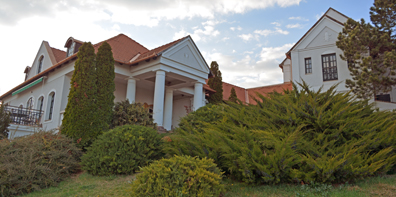 Summary: Wine enthusiasts can experience views of the landscape over vineyards, a small Hungarian village and Lake Balaton while tasting wines. Jásdi Pince, is a delightful place to spend an hour or more. The winery is located in the village of Csopak. When visitors contact the winery in advance, cold plates can be included with your tasting.
Summary: Wine enthusiasts can experience views of the landscape over vineyards, a small Hungarian village and Lake Balaton while tasting wines. Jásdi Pince, is a delightful place to spend an hour or more. The winery is located in the village of Csopak. When visitors contact the winery in advance, cold plates can be included with your tasting.
History Jásdi Pince
The vineyards of Jásdi were once owned by Bishop János Ranolder who was the Bishop of Veszprém during the 1800s. The estate was founded in 1840. The Bishop had 20 hectares (49 acres) of grapes. The cellar was built approximately 200 years ago. Bishop Ranolder built a large house above the cellar. The cellar's high ceiling was designed to accommodate horse drawn carriages for picking up wines.
István Jásdi purchased the property in 1998. At the time of Jásdi’s purchase, the property was in poor condition. The first vintage under the Jásdi label was in 1999 using sourced grapes. Jásdi researched the land and the original grape varieties planted on them. Jásdi purchased the grapes that were available for replanting the vineyards.
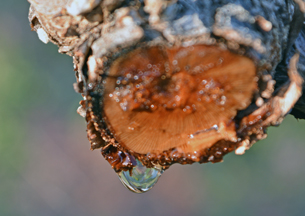 Vineyards of Jásdi Pince
Vineyards of Jásdi Pince
Today the vineyards at Jásdi consist of 11 hectares (27 acres) around the house with another 6.5 hectares (16 acres) closeby. Jásdi focuses on being environmentally friendly. Jásdi has added some solar panels. Jásdi vineyards include: Furmint, Cserszegi Füszeres, Chardonnay, Olaszrizling, Pinot Gris, Szürkebarát and Cabernet Franc. The Olaszrizling represents the wine region and is Jásdi’s largest grape variety planting. When we visited in March, we noticed a grapevine weeping just outside of the tasting room. The vineyard soil is a combination of marl, dolomite and red sandstone.
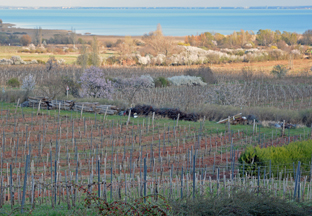 Lake Balaton affects the vineyards. In the winter the lake warms the vineyards and in the summer the lake cools the vineyards. The lake reflects the sun back to the vineyards.
Lake Balaton affects the vineyards. In the winter the lake warms the vineyards and in the summer the lake cools the vineyards. The lake reflects the sun back to the vineyards.
The vast majority of the vineyard work is done by Jásdi. However, at harvest time assistance is needed for the Olaszrizling grapes.
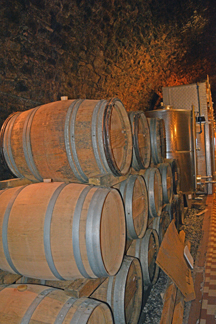 The Wine Cellar
The Wine Cellar
At the entrance to the 200 year old freestone cellar, a long flight of over 60 steps lead down to the production area. Barrels are stacked on platforms next to the stairs and below on the cellar floor where the barrels rest two and three barrels high. The high ceiling of the cellars, allows for stainless steel tanks to reside.
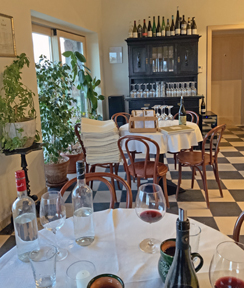 Tasting Room
Tasting Room
The tasting room is elongated with several large tables covered with white tablecloths. The decor is pleasant to look at and and includes some unusual framed artwork. Framed photographs on a pale yellow painted wall also add to the decor.
A long wall of windows and doors provided landscape views of the vineyards. The vineyards slope down toward the village and beyond to the blue Lake Balaton. Adjacent to the tasting room are numerous picnic-style tables under a wood arbor and also overlooking the nearby vineyards.
By planning a visit to Jásdi Pince in advance, visitors have the opportunity to order cold plates. Choices include: Serrano and mangalica ham, with goat, sheep or cow cheeses, seasonal vegetables and homemade bread.
The Wines
Cserszegi Füszeres 2018 was the first wine we tasted. Cserszegi is a cross between Irsai Olivér and red Traminer. In Hungarian Füszeres means spicey. This wine was 12% alcohol. The wine offered an aroma and taste of peaches and flower blossoms. The finish was crisp and fruity yielding to floral.
The Csopki 2018 had 12.5% alcohol and was crafted from Olaszrizling grapes. The wine was a light yellow color. The aroma offered tropical fruits and the velvety mouthfeel had melon and papaya. The finish was fruity.
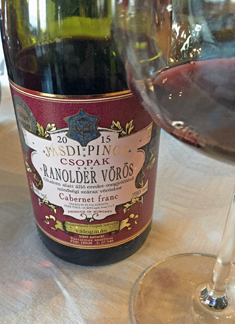 Löczedombi 2016 was produced with the Olaszrizling grape. The wine was aged in oak for 5.5 months. The yellow colored wine had a faint aroma of flowers. The taste was of daisies with some honeysuckle. The wine had a floral finish.
Löczedombi 2016 was produced with the Olaszrizling grape. The wine was aged in oak for 5.5 months. The yellow colored wine had a faint aroma of flowers. The taste was of daisies with some honeysuckle. The wine had a floral finish.
Siralomuágo 2015 also produced with Olaszrizling grapes had 13% alcohol. The yellow colored wine’s aroma was of tropical fruits. The mouthfeel was soft and included melon, papaya and citrus. The crispy finish was also fruity.
The Csopak Ranolder Feher 2015 was named for the Bishop Ranolder. The wine with 12.5 % alcohol was a blend of Furmint and Olaszrizling grapes. The yellow colored wine reminded one of a bouquet of flowers. The velvety mouthfeel had notes of daisies and some tropical fruits.
The Kékfrankos wine had 12% alcohol. The wine was a translucent ruby color. The aroma was of red and black fruits. The mouthfeel was silky and had notes of red and black raspberries as well as spices. The medium-bodied wine had mild tannins. The finish of fruit yielded to spices.
The Ranolder Vörös 2015 with 13% alcohol was produced with Cabernet Franc grapes. The wine was in French oak for 20 months. The aroma was of pepper and black fruits. The taste offered blackberries with a hint of plum. The full-bodied wine had bold tannins. The finish was fruity with some spices on the aftertaste.
Contact Jásdi Pince in advance of your visit.
Jásdi Pince
Csopak, Arany János u. 2, 8229 Hungary
Article written May 2019.
Please support the following Hungarian wineries and wine tour company.
| Wine a'More Travel |



